Father’s Day Specials
Grandpa Loves You by Helen Foster James and illustrated by Petra Brown. Sleeping Bear, 2016. Intended audience: Ages 0-6, Grade 1.
This is one of those saccharine picture books meant to read as a love letter from the adult reading to the child. The characters are adorable, fluffy bunnies. I liked the grandpa bunny’s big, bushy eyebrows. They add a touch of character and help to make the grandpa more expressive. The rhyming text relies maybe a little too heavily on pet names. This hardcover version includes a place for Grandpa to write a letter to his little honey-bunny.
**
Monster & Son by David LaRochelle and illustrated by Joey Chou. Chronicle, 2016. Intended audience: Ages 4-6.
Each page features of a different monster and its offspring doing the things that monsters do but twisting the action to make it seem benign and akin to a daily activity that a father might do with his son: like tucking the little one into bed, playing ball, or piggybacking him while approaching a city. Upset humans pout as they are caught in the tempest of the monsters’ fun, but seem unhurt. I would actually have preferred following a single monster family rather than visiting a new one each page—but because I personally like following a character, not because its a structural flaw or in picture books, and because the text indicates no switch between characters as its written in a first person narration (the father) to a second person (you, the son). This story is saccharine too (and I think that’s going to be the word of the post), but it relies less on pet names to make it so; the rhymes and story seem less forced than in Grandpa Loves You.
***
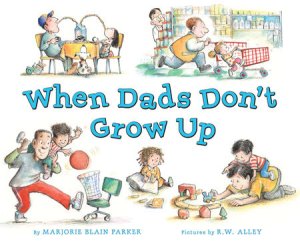 When Dads Don’t Grow Up by Marjorie Blain Parker and illustrated by R. W. Alley. Dial-Penguin Random, 2012. Intended audience: Ages 3-5.
When Dads Don’t Grow Up by Marjorie Blain Parker and illustrated by R. W. Alley. Dial-Penguin Random, 2012. Intended audience: Ages 3-5.
Perhaps because I read this one right after reading the wonderfully rhymed and rhythmic Giraffes Can’t Dance I stumbled all over the rhyme-less, unmetered text that was broken too in odd places sometimes I thought. This one pokes fun at dads and at adults, even going so far as to point out the possibility of a bald father. It claims we’ll know a dad who never grew up by the things that he does or does not do. A dad who has never grown up knows has to have fun, can’t sit still, watches cartoons, remembers how scary basements can be and that shopping carts are for racing. I would suggest it only for dads who can live up to the standard demonstrated here, but the story could backfire on a bland, grown-up dad. The illustrations of dads having fun with their kids are pretty heartwarming and goofy but the soft pastels keep the story gentle rather than raucous.
**
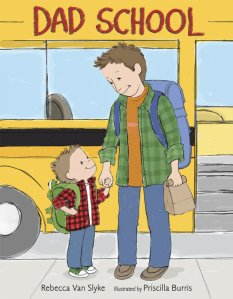 Dad School by Rebecca Van Slyke and illustrated by Priscilla Burris. Doubleday-Penguin Random, 2016. Intended audience: Ages 3-7.
Dad School by Rebecca Van Slyke and illustrated by Priscilla Burris. Doubleday-Penguin Random, 2016. Intended audience: Ages 3-7.
There’s a lot of similarities between this and When Dads Don’t Grow Up in that they both poke fun lovingly at Dad (and I capitalize it here because in both stories it is the stereotyped idea of Dad rather than a character particularly). In this one, the child (presumably the white, brunet son from the cover and common in the first few illustrations, though his classmates and his dad’s classmates are of various races) hypothesizes that his dad must have gone to Dad School to learn how to be a dad—to make huge snacks, to throw you up high but never drop you, to fix and mend things, and multitask—but suggests that he must have skipped school on the days when they learnt to clean bathrooms and match clothes and brush hair. Comparing the two books—this and When Dads Don’t Grow Up—actually gives you a fairly interesting study of the conceptual Dad. But I think I digress; I’m supposed to be reviewing a kids book not critique societal constructs. This book reads more easily than did When Dads Grow Up, but it also came before rather than after Giraffes Can’t Dance. It too could backfire on a dad who does not do these things or conversely who does do the things that it is suggested by the text that a dad should not do.
***
Animal Friends
 Giraffes Can’t Dance by Giles Andreae and illustrated by Guy Parker-Rees. Orchard-Hachette, 2001. First published 1999. Intended audience: Ages 5-7, Grades PreK-2.
Giraffes Can’t Dance by Giles Andreae and illustrated by Guy Parker-Rees. Orchard-Hachette, 2001. First published 1999. Intended audience: Ages 5-7, Grades PreK-2.
I first read this book in March 2013 and according to Goodreads I haven’t read it again since, though I’m not sure if I believe that and I know I’ve handed it to many customers since. I read this among a wealth of Father’s Day themed books. Perhaps it stood out because of that, but I think it was more than that. This is a good story, carefully metered and well-rhymed with a bit of poetry to the prose. There’s a lot of raw emotion from the giraffe, ridiculed and told that he can’t, and an important moral about being able and being different and being okay. I’d grabbed it that day when I was otherwise reading books about dads because the kids were getting antsy, and I thought that this might be a dance-along book, and I maybe could have made it so, but I got wrapped up in the story myself and we never danced. Parker-Rees’ illustrations are jewel-bright and just a delight, awash with detail and vibrancy.
*****
When Your Elephant Comes to Play by Ale Barba. Philomel-Penguin Random, 2016. Intended audience: Ages 3-7.
This story was a bit more lackluster than I’d hoped it might be. There’s a lot that you can’t do with an elephant and still have fun yourself—like going swimming in the pool or eating cake—but elephants are excellent huggers. There’s a lot of color and line in the illustrations—almost like a more concrete Kandinsky, and while that feels fresh, it’s also almost distracting; the illustrations take work to grasp and dissect and made it at times difficult to find the text.
***
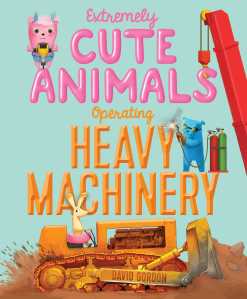 Extremely Cute Animals Operating Heavy Machinery by David Gordon. Simon & Schuster, 2016. Intended audience: Ages 4-8, PreK-3.
Extremely Cute Animals Operating Heavy Machinery by David Gordon. Simon & Schuster, 2016. Intended audience: Ages 4-8, PreK-3.
I had heard some so-so reviews of this book before I actually got around to reading it and so was rather pleased with the story. Karen—an extremely cute but unidentifiable animal (maybe a kangaroo?)—wants to build a sand castle, but the playground bullies won’t allow it. They destroy her castle, but she and a few friends build a new castle, bigger and better. That too is destroyed, and the friends rebuild, bigger and better. After a third time, the extremely cute animals get extremely mad, and they haul away the whole playground with a helicopter and come in with steel beams and welding guns and create a walled and gated theme park where no bullies are allowed. And I would have been upset if that had been the end, but Karen cracks open the door to invite the momentarily exiled bullies into the park, where they seem very contrite as they are led around the park and shown kindness by the extremely cute animals, who have not forgotten to build something for even those who like to destroy—a replica of Karen’s original castle this time meant to be destroyed (and presumably rebuilt and destroyed again). The cotton-candy quality of the illustrations and the title’s description of the protagonists as cute did not particularly bleed into the text itself, which was more realistic and hard-hitting than a lot of picture books that I’ve read recently. The bullies’ speeches seemed particularly realistic—not cleaned up, not made cute or trite, just down in the dirt mean. And I appreciated that kind of unmade-up depiction of bullies. I’ve not read a lot of picture books talking about how to deal with bullies. There’re Peanut Butter & Cupcake and I suppose Giraffes Can’t Dance too, where the characters who exclude Peanut Butter and Giraffe could be classified as bullies but never are, and there’s Llama Llama and the Bully Goat, where the rhyming text sort of diminishes the roughness and the ending makes it seem like Bully Goat is reformed by one time-out. I do dislike that extremely cute and good and kind seem to be equated and—while I understand it as part of the repetition of a picture book text—the part of me that writes novels and has been trained in school to write essays disliked that repetition of the weak word “extremely.” That these cute, good protagonists are allowed to get mad, and that their anger is siphoned constructively I do like.
****
 Bright Baby Touch and Feel: Perfect Pets by Roger Priddy. Priddy-Macmillan, 2006. Intended audience: Ages 1-3, Grade PreK.
Bright Baby Touch and Feel: Perfect Pets by Roger Priddy. Priddy-Macmillan, 2006. Intended audience: Ages 1-3, Grade PreK.
I was pleasantly surprised by this board book. Each spread takes a moment to name an animal—no, actually give the pet a name—and describe an action associated with that animal. The pages are touch-and-feel but the text does not always prompt the reader to describe the texture. A solid background color behind the photographed illustration could let this book be used as a color primer too. But there is more story here and certainly more characters than I’ve grown to expect from primers because of the names, because of the actions; I welcome that.
****
 An Elephant and Piggie Book: I Am Invited to a Party! by Mo Willems. Hyperion-Disney, 2007. Intended audience: Ages 4-8.
An Elephant and Piggie Book: I Am Invited to a Party! by Mo Willems. Hyperion-Disney, 2007. Intended audience: Ages 4-8.
This was a new Elephant and Piggie story for me. Even though it is one of the older stories (the third written in the series), it had never been in my hands. I love it. Piggie is invited to a party, but doesn’t want to go alone. Gerald agrees to go with her, because he knows parties. Gerald prepares for every eventuality and their outfits become more and more ridiculous as they prepare for a fancy pool costume party. In the end, Gerald has worried just enough to make them prepared. Everyone looks ridiculous in their outfits for the fancy-pool-costume party. I had fun trying to pick out the costumes from the final illustration. Also, what a great time to break out paper dolls!
*****
 An Elephant and Piggie Book: Elephants Cannot Dance! by Mo Willems. Hyperion-Disney, 2009. Intended audience: Ages 4-8.
An Elephant and Piggie Book: Elephants Cannot Dance! by Mo Willems. Hyperion-Disney, 2009. Intended audience: Ages 4-8.
Piggie is excited about dance class and wants to teach Gerald to dance, but Elephants cannot dance; it’s in the handbook. Trust Piggie to find the loophole. So Gerald tries to dance, but Willems takes a bit of time to play with opposites. When Piggie says up, Gerald goes down. When Piggie tells him to do the robot walk, he wiggles and waggles. Just when Gerald is ready to give up, along come two squirrels who want to learn the Elephant dance, teaching that just because you feel like you’re failing does not mean that you are failing and different is not wrong or bad.
****
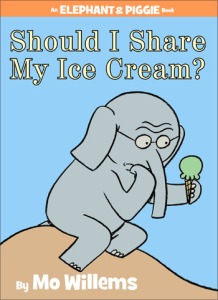 An Elephant and Piggie Book: Should I Share My Ice Cream? by Mo Willems. Hyperion-Disney, 2011. Intended audience: Ages 4-8.
An Elephant and Piggie Book: Should I Share My Ice Cream? by Mo Willems. Hyperion-Disney, 2011. Intended audience: Ages 4-8.
This Elephant and Piggie story I’d read before, but apparently never reviewed. Gerald buys an ice cream cone and in his excitement only realizes later that maybe he should have bought Piggie one too. Gerald talks himself into and out of sharing his ice cream with his best friend and while he waffles on what is right, the ice cream melts away, leaving neither of them with a tasty treat. Luckily, Piggie has his back, and appears with an ice cream cone of her own to share with Gerald and to cheer him up after Gerald has upset himself by wasting the ice cream cone that neither he nor Piggie enjoyed.
****
An Elephant and Piggie Book: Let’s Go for a Drive! by Mo Willems. Hyperion-Disney, 2012. Intended audience: Ages 4-8.
This was a new Elephant and Piggie story for me! Gerald wants to go for a drive with Piggie, but in typical Gerald style, Gerald worries, and wants to be prepared for any type of weather and for everything that could go wrong on their drive. Piggie is a prepared pig. She has everything Gerald requests: a map, sunglasses, umbrellas, bags to pack it all in—everything except a car. That is when the pattern of the text breaks too. Piggie saves the day again though by coming up with an alternative idea. The two make a pirate ship out of all the things that they’ve collected for their drive, and have fun anyway. Willems uses a road map for his illustrations of the map, making this an example of mixed media illustration, if most of the illustrations adhere to his usual drawing style. This would be a story better told while standing, so that the reader can act out the celebratory dancing. While sitting, the celebratory singing just didn’t have the same effect. Now I know.
****
Hero of Your Own Story 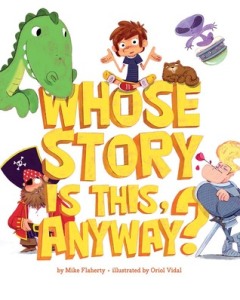 Whose Story Is This, Anyway? by Mike Flaherty and illustrated by Oriol Vidal. Sterling, 2016.
Whose Story Is This, Anyway? by Mike Flaherty and illustrated by Oriol Vidal. Sterling, 2016.
I read this alongside of Monster & Son, When Your Elephant Comes to Play, and Hoot and Peep, and this was declared the favorite by the little boy at story time whom I polled. This is the story of a boy who wants to tell a story about himself—with a cameo by his cat, Emperor Falafel—but the story keeps getting interrupted by pirates and knights and dinosaurs and aliens. He shouts them all away, but realizes that the audience for his story actually prefers a story with pirates and knights and dinosaurs and aliens and rewrites his story to include them all. The competing voices in the story are what I think make this so much fun: a deep growling voice of “arr” and “yar” and “ye” for the pirate, Salty Pete; a proper, clipped voice for Sir Knightly; a sort of dopey voice with lots of rounded tones that I gave the dinosaur; and a sort of shrill, nasal voice for the boy. Now, I’m not sure how I feel about the idea that a story about an ordinary boy and his cat is dull and yawn-inducing, but the idea that a story is better with friends and with characters I can get behind. I think it would be a fun story to use when talking about story writing.
****
 Oh, The Places You’ll Go! by Dr. Seuss. Random, 1990.
Oh, The Places You’ll Go! by Dr. Seuss. Random, 1990.
I read this to a group that consisted primarily of kids under 7 and one that was maybe 10 at my best guess. It is Dr. Seuss. Everyone loves Seuss. I expected it to be fine. I expected them to like it. It was too long for all of them, and the 10 year old thought it was a bit too dark and depressing. This is of course a classic. I know it. You probably know it too. And we can probably both quote it. It’s a tale about life, that assures the reader that she is ready and able to take on the world, that she knows what she needs to know and has the gumption to get things done and to go to great places, but also warns that life doesn’t always go the way that it should, that there will be bad paths to avoid, dark places she’ll end up even if she’s done everything right, slumps and waiting. The message is inspiring, but apparently, it really is better for those high school and college graduates if they’re willing at that age to give it a read.
***
These reviews are not endorsed by any of the authors or publishers or anyone else involved in the making of these books. They are independent, honest reviews by a reader.




